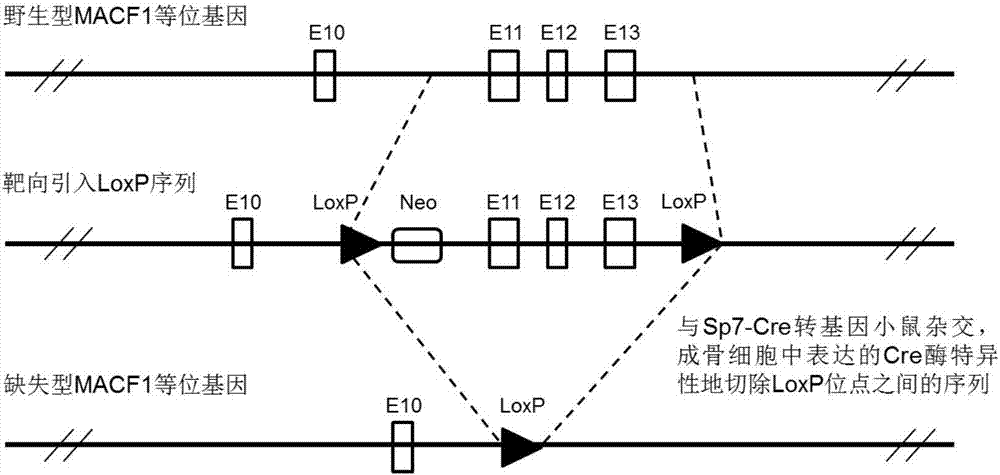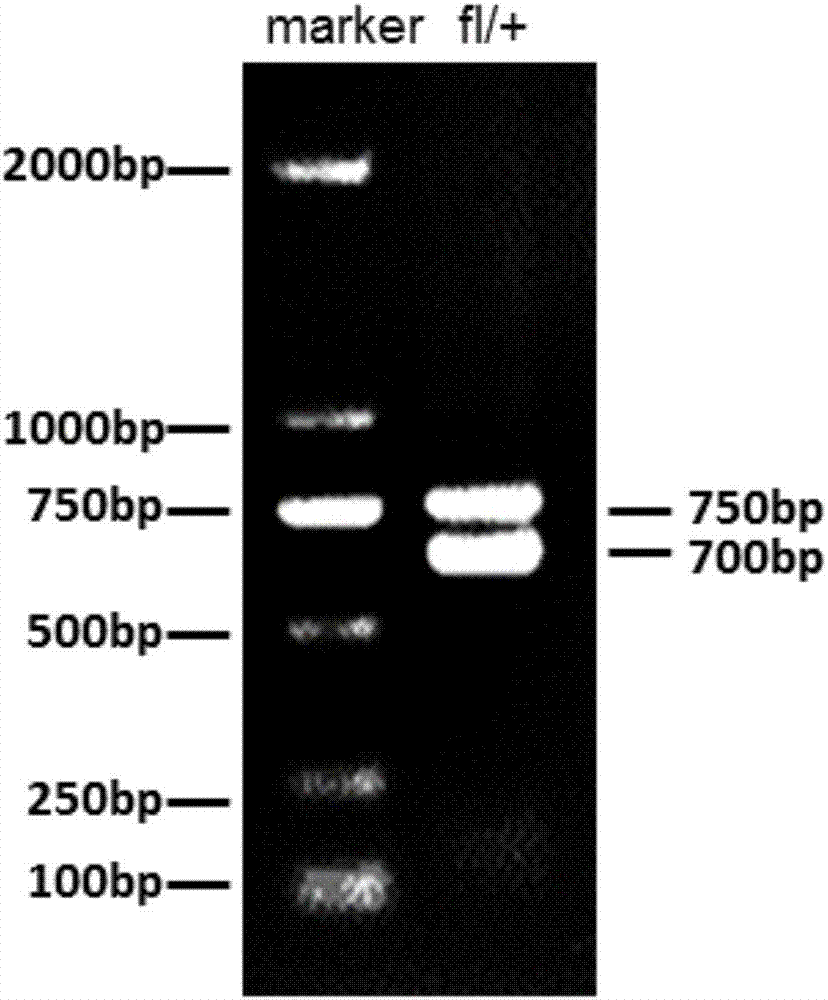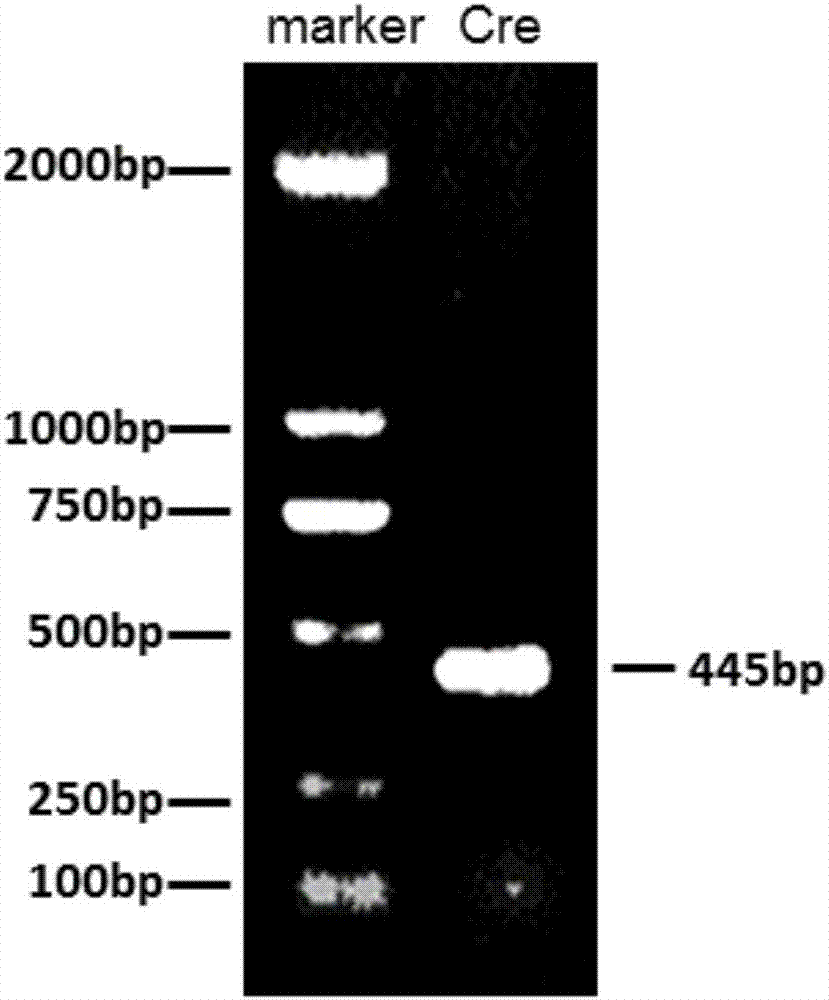Construction and application of mouse model with conditional knockout of MACF1 gene in osteoblast
An osteoblast, mouse model technology, applied in the field of biomedicine, can solve problems such as incomplete response
- Summary
- Abstract
- Description
- Claims
- Application Information
AI Technical Summary
Problems solved by technology
Method used
Image
Examples
Embodiment 1
[0050] Example 1: Construction of a mouse model in which the MACF1 gene is conditionally knocked out in osteoblasts.
[0051] 1.1 Experimental animals.
[0052] MACF1 fl / + Breeding of mice and Sp7-Cre transgenic mice.
[0053] MACF1 fl / + Mice and Sp7-Cre transgenic mice entered the breeding area after isolation and observation, and no abnormalities were found. The feeding was carried out in accordance with the SPF animal feeding standards, and the experimental operations were strictly carried out in accordance with the relevant regulations of SPF animal management.
[0054] 1.2 MACF1 fl / + Mouse genotyping
[0055] Clip mouse toes and extract MACF1 fl / + Mouse genomic DNA, using primers for mouse genotype identification; using the mouse MACF1 gene sequence as a template, the specific primer sequences are designed as follows:
[0056] AP179: 5'-AAAGAAACGGAAATACTGGCC-3';
[0057] AP180: 5'-GCAGCTTAATTCTGCCAAATTC-3'.
[0058] refer to figure 2 , PCR identification results...
Embodiment 2
[0069] Example 2: Detection of the expression of MACF1 in osteoblasts of a conditional knockout mouse model.
[0070] Newborn mouse calvarial osteoblasts were taken, and their RNA was extracted for SYBR green Real-time Quantitative PCR (qRT-PCR) to detect the expression of MACF1 at the mRNA level, so as to verify the conditional knock-out of MACF1 in osteoblasts. The low expression in osteoblasts of the mouse model was excluded, thus confirming that the animal model was successfully constructed.
[0071] refer to Figure 5 , MACF1 in Sp7-Cre; MACF1 fl / fl The expression level in mouse osteoblasts was significantly lower than that of MACF1 fl / fl mice, indicating that the mouse model for conditional knockout of the MACF1 gene in osteoblasts was successfully constructed.
Embodiment 3
[0072] Example 3: The effect of knocking out MACF1 in osteoblasts on the expression of related osteogenic genes in mouse osteoblasts.
[0073] Newborn mouse calvarial osteoblasts were collected, and their RNA was extracted for qRT-PCR to detect the expression of osteogenic differentiation marker genes (ALP, RUNX2, COL-I, OCN).
[0074] refer to Image 6 , it was shown that, with MACF1 fl / fl Mice compared to Sp7-Cre;MACF1 fl / fl The expression levels of related osteogenic genes in mouse osteoblasts were significantly reduced, indicating that knocking out MACF1 in osteoblasts reduced the differentiation ability of osteoblasts.
PUM
 Login to View More
Login to View More Abstract
Description
Claims
Application Information
 Login to View More
Login to View More - R&D
- Intellectual Property
- Life Sciences
- Materials
- Tech Scout
- Unparalleled Data Quality
- Higher Quality Content
- 60% Fewer Hallucinations
Browse by: Latest US Patents, China's latest patents, Technical Efficacy Thesaurus, Application Domain, Technology Topic, Popular Technical Reports.
© 2025 PatSnap. All rights reserved.Legal|Privacy policy|Modern Slavery Act Transparency Statement|Sitemap|About US| Contact US: help@patsnap.com



